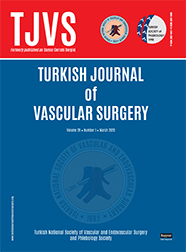
The Turkish Journal of Vascular Surgery
Yazarlar: Hakkı Tankut AKAY, Ali HARMAN, Mehtap UYAR ERKMEN, Fatih BOYVAT
Konular:-
Anahtar Kelimeler:Abdominal aortic aneurysm; endovascular stent graft; renal failure; dialysis
Özet: Objective: We aimed to analyze the results of elective endovascular aneurysm repair (EVAR) in patients with mild renal dysfunction. Material and Methods: Between April 2004 and August 2012, a total of 137 consecutive patients underwent elective EVAR, mostly under local anesthesia. We compared our results in the patients with normal renal functions (n=107), and the patients with preoperative mild renal dysfunction (serum creatinine 1.5-2 mg/dl, n=30). The operations were performed by the same group of vascular surgeons and radiologists, in a single institution. Preoperative, postoperative, and follow-up serum creatinine and creatinine clearance, demographic data, risk factors, hospital stay, morbidity and development of postoperative renal impairment were compared between the groups. Results: There was a significant difference between two groups for postoperative renal complications. Renal complications (5 patients) included contrast-induced acute renal failure in 4 patients in group II, and in one patient in group I. Those patients recovered with 2 or 3 dialysis sessions, without being dialysis-dependent permanently. Univariate and multivariate analyses indicated that presence of coronary artery disease, low ejection fraction, pre-existing renal dysfunction, use of larger volumes of contrast agent, and presence of a difficult anatomy (such as juxtarenal aneurysm, short landing zone) significantly increased the risk for postoperative serum creatinine increase, and pre-existing renal dysfunction, low ejection fraction and high volumes of contrast agent use increased the risk for dialysis. Conclusion: EVAR with intra-arterial contrast agents can be accomplished in patients with chronic renal insufficiency who do not require dialysis,with limited and acceptable morbidity and mortality. However, temporary dialysis and and a slight increase in serum creatinine levels should be expected. Our study showed that mild renal insufficiency, low ejection fraction, and high volumes of contrast agent use increased the risk for dialysis. Low ejection fraction, coronary artery disease, renal dysfunction and high volumes of contrast agent use are significant risk factors for postoperative increase in serum creatinine.